The Importance and Applications of Polyethylene in Film Casting
Versatile Polymers for Film Casting
Film casting frequently uses polymers like low-density polyethylene (LDPE), high-density polyethylene (HDPE), and linear low-density polyethylene (LLDPE) due to their versatility and suitability for a wide range of applications.
Each of the three polymers —LDPE, HDPE, and LLDPE— possesses unique mechanical and other properties. While LDPE is known for its toughness and flexibility, it has less tensile strength than HDPE and LLDPE. On the other hand, HDPE has good stiffness, strength, and chemical resistance. LLDPE, a longer-chain ethylene copolymer, provides an ideal balance between flexibility and strength, resulting in greater tear strength and resistance to puncture. Furthermore, whereas LDPE is easy to manufacture due to its low melting point, HDPE and LLDPE have greater melting points, making them more suitable for tough applications.
LDPE is preferred for general-purpose films, packaging films, bottles, carrier bags, shrink films, freezer films, lamination, and pouches due to its toughness and flexibility. Amirkabir, Aryasasol, Mahabad, and Bandar Imam Petrochemical Companies are the largest manufacturers of raw materials for LDPE films.
The different grades of LDPE raw material used in films are shown below. These LDPE films will be exported with the HS code 39011030.
Analysis of LDPE films grades
You can find the list of LDPE films products in the table below:
Because of its strength and rigidity, HDPE is used in industries requiring more durable materials and heavier-duty bags, like shopping and carrier bags, liners, garbage bags, wrapping films, and enhanced ultra-thin films. Mehr, Aryasasol, and Jam Petrochemical Companies are among the main producers of raw materials for HDPE films.
Below, you can see different grades of HDPE films. These HDPE films will be exported with the HS code 39012020.
Analysis of HDPE films grades
You can find the list of HDPE films products in the table below:
Also, LLDPE is used for general purposes such as packaging films, liners, agricultural films and tapes, blending, lamination, stretch films, heavy-duty sacks, and cable coverings because it combines the qualities of LDPE and HDPE. Jam, Tabriz, Mahabad, Shazand Petrochemical, and Bakhtar Group Companies are the largest LLDPE film raw materials manufacturers.
Here are the various LLDPE films. These LLDPE films will be exported with the HS code 39011010.
Analysis of LLDPE films grades
You can find the list of LLDPE films products in the table below:
You can also download the catalogue by clicking this button.
Petro Nour Mehr company can export raw materials required for manufacturing various products in the industries above at the best costs and with the greatest quality.
Applications of Film Casting
Bags
Film casting is required to produce many packaging materials used in bag manufacturing. For example, LDPE film is widely used in the manufacture of retail bags, trash bags, and agricultural bags.
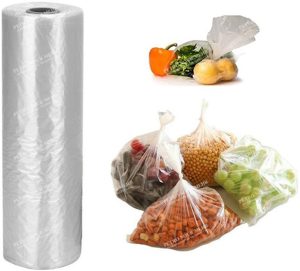
Using LDPE film to produce freezer bags
Stronger and more rigid HDPE films are used to make heavy-duty bags, such as supermarket bags and industrial liners.

Using HDPE film to produce shopping bags
Lamination and Packaging
During lamination, film casting is used to form thin polymer films that cover or protect various materials. Polymer films obtained from film casting, for instance, are laminated onto paper or aluminum foil to form multi-layered structures with barrier qualities for manufacturing flexible packaging materials like pouches and sachets. These laminates are widely used where product protection is crucial, like in food packaging. With the precise control of film thickness and qualities made possible by film casting, lamination performance, and product quality are maximized.
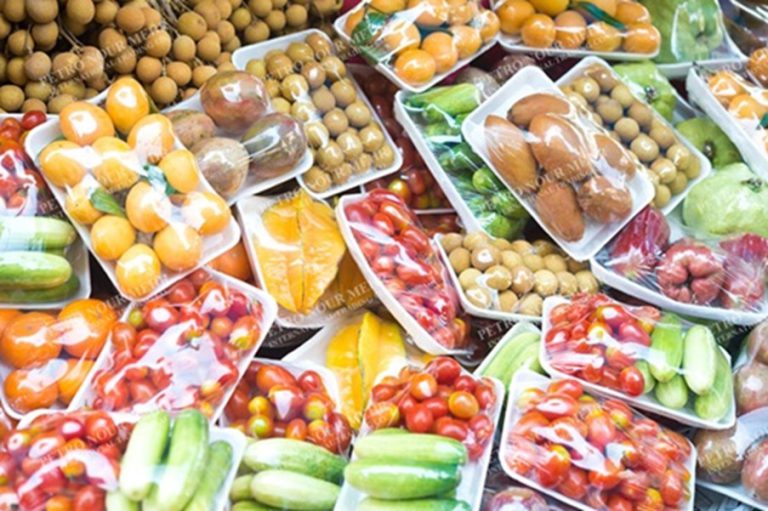
Using film casting in food packaging
Shrink Films
Shrink films are used to package a variety of items. Polymer resins, such as polyethylene, are heated and extruded into thin sheets, then quickly cooled and stretched to improve strength and clarity. When heated, the film conforms closely to packed materials, offering a secure fit for food, consumer goods, and industrial products.
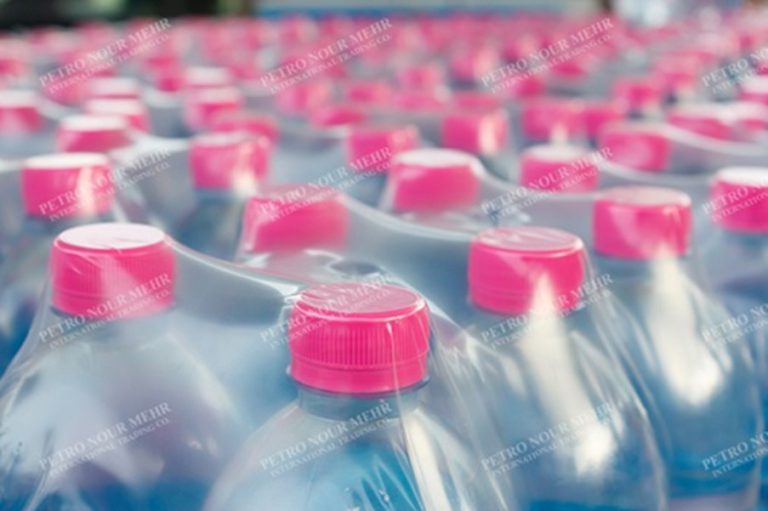
An example of shrink film
Stretch Films
Stretch films are essential for stabilizing palletized loads during transit and storage. Polymer blends, primarily LLDPE, are melted, extruded into thin films, chilled, and stretched to increase tensile strength and flexibility.
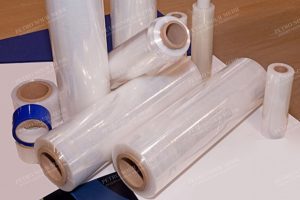
An example of stretch film
Agricultural Films
In agriculture, film casting of polymers is the process of creating thin polymer films for a variety of purposes, including greenhouse covering, mulching, and retaining soil moisture, among other uses. These films aid in water conservation, temperature control, and weed control in agriculture, ultimately improving crop quality and yield. They can also serve as barriers, keeping pests and diseases away from crops.

Using LLDPE film to make agricultural films
Pouches
The film casting procedure is used in the pouch manufacturing process to create the pouch’s material. There are many advantages. One of the most important is that film casting allows precise control over film thickness, which is critical for pouch strength and flexibility. Furthermore, the method is scalable and relatively inexpensive, making it ideal for large-scale production.
Bottles
The industry prefers to use film casting of polymers for bottle production since it has numerous advantages. First and foremost, it allows for the addition of unique characteristics to bottles that are appropriate for their intended purpose, such as barrier properties for preservation or clarity for product visibility. Film casting also makes design flexibility possible, enabling the production of bottles in a variety of sizes, shapes, and designs to satisfy customer preferences and branding specifications.
High Stiffness Uses
Polymer film casting provides numerous advantages for industries such as electronics, packaging, and construction that require films with a high level of stiffness. It allows for the production of films with controlled thickness and uniformity, resulting in consistent mechanical properties like stiffness.
Electronics
Film casting is essential in the electronics industry, especially in the manufacture of cable insulation for high-performance electronic displays. This procedure, which frequently uses polymers, results in the development of thin, homogeneous films that serve as critical insulation components in cables.
Amcor is a global pioneer in designing and manufacturing ethical packaging solutions. They employ film casting processes to make various flexible packaging items, such as bags, pouches, and packaging.
Petro Nour Mehr Co. may supply and export any materials required for any of the above applications.
Polymer Film Casting Procedure
Film casting of polymers is the process of pouring a polymer solution or melt onto a substrate and allowing it to solidify to form thin films, which is widely used in industrial settings. In the beginning, a polymer suited to the desired film properties, such as strength, flexibility, and transparency, should be selected carefully. Next, the polymer is prepared by melting it or dissolving it in a solvent to produce a homogenous melt.
Pre-treatment in film casting plays a significant role in ensuring that substrates, like glass or metal, are carefully cleaned and ready to guarantee that the polymer film adheres properly. The polymer solution or melt is poured or spread across the substrate during the casting process using spin coating, dip coating, or knife coating processes.
Once dried or solidified, the film casting method produces a thin polymer film, allowing the solvent to evaporate or the melt to cool and solidify. Post-treatment procedures such as annealing or surface modification are optional for improving film quality.
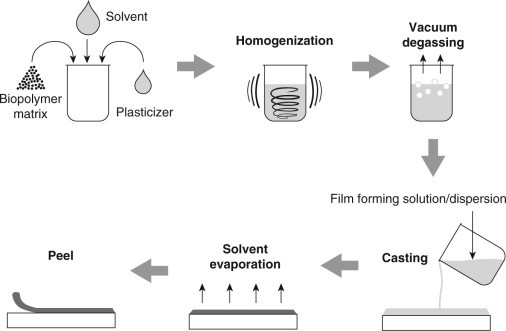
Schematic of film casting procedure
Advantages of Film Casting
Film casting provides a versatile method for producing thin films with a variety of characteristics, including strength, flexibility, transparency, and barrier qualities. Because of their versatility, films can be made specifically for industrial uses.
Also, another advantage is that by creating thin films with consistent thickness and characteristics, the film casting method may result in uniformity in the final product.
Film casting is well suited for companies requiring huge volumes of production since it can readily scale up for mass production.
Finally, there are several reasons why film casting is so economical: By precisely controlling the use of materials, film casting reduces waste while increasing efficiency. Also, film casting usually requires less sophisticated and costly equipment than other manufacturing techniques like extrusion or injection molding.
Furthermore, film casting can produce goods quickly, which allows producers to effectively manage large order volumes. Economies of scale are made possible by the ability to increase output without experiencing significant increases in cost per unit, thereby improving cost-effectiveness.
Moreover, compared to other manufacturing techniques, film casting offers a production process that is more efficient and involves fewer intermediate steps. Due to the reduction of labor costs, production time, and the risk of defects, manufacturers can save money overall as a result of this simplicity.
Challenges in Film Casting
Choosing the appropriate solvent or melting point for the polymer is a challenge when casting films. The solubility properties and melting points of different polymers can affect the casting process and the quality of the film that is produced. Furthermore, the process’s environmental impact can be affected by the solvent or melting temperature selected, emphasizing the importance of environmentally friendly and sustainable solutions.
Furthermore, it may be difficult to maintain consistent film properties across large production batches, particularly regarding mechanical and thickness parameters. Variations in equipment performance, processing conditions, and raw material quality can all result in inconsistent finished products.
To overcome these obstacles, continuous research and development are needed to create and enhance film casting methods. Manufacturers may further strengthen film casting’s position as a crucial production method across a range of industries by improving the efficiency, quality, and sustainability of their operations through continual process refinement and adoption of new technologies.
Environmental Considerations for Film Casting
Energy-efficient drying technology and solvent-free casting techniques are two initiatives aimed at reducing these effects. Eco-friendly options for film casting applications include recyclability and sustainability characteristics found in polymers like LDPE, HDPE, and LLDPE. Film casting operations can reduce their environmental impact while upholding high production standards by implementing these strategies.
Quality Control in Film Casting
To ensure a constant production of thin polymer films, quality control is essential in the film casting process. Adhesion, uniformity, and film thickness are among the parameters that are regularly checked. Reliability is ensured by sophisticated methods such as adhesion testing and online monitoring. In general, quality control procedures guarantee that films consistently fulfill industry standards.
Emerging Trends in Film Casting Applications
Sustainability is becoming increasingly important as people become more aware of environmental issues such as plastic litter. Incorporating smart additives improves film performance while also meeting specific needs in electronics, food packaging, and healthcare.
Additionally, the need for customized film goods is being fueled by the expansion of e-commerce and personalized markets, which is made possible by the small-batch and rapid prototyping capabilities of film casting. Technological convergence is also creating new opportunities for multifunctional films with improved qualities, which have prospective uses in electronics, healthcare, and energy storage. One example is the combination of film casting with sophisticated manufacturing methods like 3D printing and nanomanufacturing.
Innovations in Film Casting Technology
Significant technological advances in the film casting industry have transformed the procedure, resolving issues and improving effectiveness. Innovations include developing new polymers and post-treatment techniques that enhance film quality while cutting expenses and broadening application scope.
Novel formulations designed for specific film casting requirements have emerged as a result of advances in polymer materials. Reactive extrusion and additive manufacturing, two developments in polymer processing techniques, allow for exact control over the properties of films. Process optimization is aided by computational modeling, and outstanding film uniformity and surface quality are guaranteed by advances in equipment design.
Furthermore, post-treatment techniques like surface modification enhance the properties of films used in biomedical materials, electronics, and food packaging.
How to order
- Purchase from a trustworthy provider with credentials to ensure quality.
- Compare the pricing of these materials in various markets with the global market price.
- Examine the sales conditions, including quantity, delivery time, packaging, transportation methods, and payment terms.
- Contact Petro Nour Mehr Company to acquire the best export price according to your requirements.
- Petro Nour Mehr Company provides secure and suitable payment methods based on consumer preferences.
- It’s notable that our company has contact with several reputable transportation providers which can assist you find the best solutions.
- Also, the company provides customers with the necessary documentation for customs clearance in their final city.